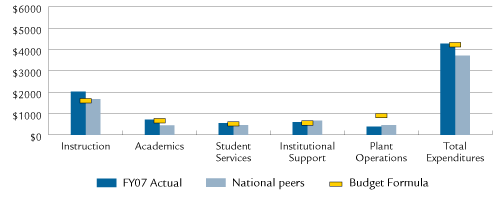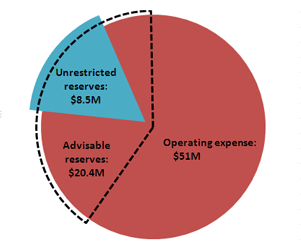Bristol Community College
Bristol Community College (BCC) primarily serves residents of Bristol County and southeastern Massachusetts, providing programs that nurture the region’s economic health and enable individuals to make productive life choices. In April 2004, Bristol Community College was identified as “a model two-year college” in a Boston Globe editorial series on workforce development. The editorial praised the College for partnerships with local businesses and practical programs that benefit students and economic development.
Program of Distinction
Collaborations
Access Indicators
Affordability Indicators
Student Success and Academic Quality Indicators
Fiscal Effectiveness and Efficiency Indicators
Program of Distinction
The future is small—with small business and entrepreneurial thinking, that is. To reach out to the micro-engines of the economy, BCC established the Academic Center for Entrepreneurship (ACE) to provide business planning skills and networking opportunities for high school and BCC students, alumni and community members. Since its establishment in 2006, more than 500 people have taken advantage of the Center’s services. ACE grew out of a BCC degree program in Entrepreneurship, buttressed by research indicating that small business and incubator projects in the region could provide a whole new career pathway that would nourish the local business community. Started under the Presidential Fellowship professional development program initiated by BCC President John J. Sbrega, ACE has become a resource center for local entrepreneurs, and has also assisted high school and college students plan careers as entrepreneurs. Services include mentoring, counseling for small business owners, desk-incubation opportunities, youth entrepreneur programs and high school and college faculty training. Businesses developed in the region include a child-care facility, fitness center, support service for the hearing impaired and a medical billing company.
Collaborations
- BCC has created programs in high schools that admit students on the spot and provide on-site placement testing or expedited appointments on campus. With “On-the-Spot Admissions,” counselors meet with students at their high schools, review applications and admit students on-the-spot. In Fall 2008, the college admitted 664 students through this program. In addition, Tech Prep Coordinators at nine area high schools were trained in administering Accuplacer tests through the Bristol Assessment Center. Two hundred and eighteen students were tested at their high schools, and the students received immediate results which enabled them to register for their first-year courses. Not only is this program convenient for students, it also stretches limited resources at the College campuses.
- The Employer in Residence Program, representing a collaboration between MEDITECH and the BCC Career Center, builds connections with this large employer, BCC alumni, employees, faculty and students to provide real-time career development and advice. MEDITECH human resources personnel spend time on campus offering individual résumé critique, mock interview sessions and workshops on making a positive impression on human resource professionals. Students have been invited to the MEDITECH offices for a Job Shadow Day, and faculty members have worked directly with MEDITECH to explore and keep up with evolving skills needed by new graduates and remain knowledgeable about career paths within the industry.
- BCC’s Nursing Department will be Bristol County’s lead academic partner in a national children’s health study funded by the National Institutes of Health. Brown University and Women & Infants Hospital are the lead agencies for this study, which will include children from more than 100 counties across the country. In recruiting BCC to participate, researchers at Brown believe that the partnership will “provide research experience for the faculty and staff as well as provide job opportunities for students.”
- Service-Learning students at Bristol Community College created an after-school enrichment program for a city elementary school in BCC’s Fall River Campus neighborhood. Led by two BCC students, the program recruited other BCC students and staff to offer a variety of after school classes to children in grades one through five. Classes included conversational Japanese, knitting, theatre, playwriting, drawing, American Sign Language and German. BCC students received effective teacher training and created lesson plans and projects for six-week courses. More than 40 BCC students and staff participated over the two semesters, and well over 200 children in the school took advantage of the program. “Be Enriched” continues this academic year.
- To “green” the tourism profession, BCC has collaborated with tourism leaders to create the first North American college curriculum program in “Geotourism—Destination Planning.” The discipline prepares professionals who focus on the development of sustainable tourism operations that honor a community’s values and goals. Students earn an associate’s degree and are able to earn a marketing certificate jointly with The George Washington University. To launch the new program, the College sponsored a conference with the National Geographic Society's Center for Sustainable Destinations. More than 60 local tourism professionals participated. The degree program is garnering international interest, including the opportunity to develop sustainable partnerships in Montreal.
Section I: Access to Public Higher Education in Massachusetts
Access Indicators
Fall 2007 Enrollment
| Headcount |
7,388 |
| FTE |
4,511 |
Fall Enrollment
Over the last three years, fall headcount enrollment has increased 7.5%.
Over the last three years, fall full-time equivalent (FTE) enrollment has increased 9.1%.
Annual 2007–2008 Enrollment
| Headcount |
10,449 |
| FTE |
4,555 |
Annual Enrollment
Over the last three years, annual headcount enrollment has increased 11.6%.
Over the last three years, annual FTE enrollment has increased 12.4%.
Looking Back: Fall and Annual Headcount Enrollment

Fall 2007 Minority Enrollment
13.3%
Minority Enrollment
Greater than the minority representation of the institution's primary draw cities and towns (10.4%) and the Southeast Region's minority representation of 10.8%.
Section II: Affordability of Massachusetts Community Colleges
Affordability Indicator
2007–2008 Tuition and Fees as a Percent of Median Family Income
4.8%
% of Median Family Income
Comparable to the Northeast regional average of 4.9%.
Looking Back: Tuition and Fees as a Percent of Median Family Income
|
FY2004 |
FY2005 |
FY2006 |
FY2007 |
FY2008 |
| Bristol Community College Tuition and Fees |
$3,060 |
$3,240 |
$3,750 |
$3,750 |
$3,750 |
| State Median Family Income |
$67,527 |
$68,701 |
$71,655 |
$74,463 |
$78,497 |
| "X" as a Percent of State Median Family Income |
| X = Bristol Community College Tuition and Fees |
4.5% |
4.7% |
5.2% |
5.0% |
4.8% |
| X = Massachusetts Community Colleges' Average Tuition and Fees |
4.8% |
4.9% |
4.9% |
4.7% |
4.7% |
| X = Northeast Average Tuition and Fees |
|
4.8% |
4.8% |
4.9% |
4.9% |
Section III: Student Success and Academic Quality
Success and Quality Indicators
Fall 2006 Cohort First-Year Persistence Rate
| Retained at original institution |
63.6% |
| Retained at any institution |
69.8% |
Fall Cohort First-Year Persistence
Persistence at original institution has increased 2.6 percentage points over the last three years and is above the segmental average of 56.5%.
Looking Back: Fall-to-Fall First-Year Persistence Rate

Fall 2003 Cohort Four-Year Overall Success Rate
71.5%
Fall 2003 Cohort Four-Year Individual Success Rates
| Earned Degree/Certificate |
36.9% |
| Transferred |
10.3% |
| Earned 30 Credits |
22.6% |
| Still Enrolled |
1.8% |
| Note: Each subsequent category excludes any student included in previous category(ies) |
Fall Cohort Four-Year Overall Success Rate
This new indicator measures students who have earned a degree/certificate, transferred to another institution, earned 30 or more credits, or are still enrolled after four years. Future reports will include these outcomes over four, five, and six years for this and successive cohorts. Please see the Technical Guide for further details regarding this indicator.
2007–2008 Fall-to-Spring Retention Rate
93%
Fall-to-Spring Retention Rate
Fall-to-spring retention has remained relatively stable over the last three years.
FY2008 Credit Course Completion Rate
78.4%
Course Completion
Above the Board of Higher Education's target rate of 75%.
Total Degrees Conferred in FY2008
1,001
Degrees Conferred
Average degrees conferred per year over the last three years: 970
Looking Back: Degrees Conferred

2007 Pass Rate on the National Nursing Licensure Examination
96.6%
Nursing Exam Pass Rate
Above the Board of Higher Education's target pass rate of 85%.
FY2008 Annual Enrollment in Workforce Development Courses
13,384
Workforce Development
Average annual enrollment in workforce development courses per year over the last three years: 12,863
Section IV: Effective and Efficient Use of Resources
Effectiveness and Efficiency Indicators
Effective Projects and Initiatives
- The College installed a 10kW photovoltaic system for both sustainable and academic uses. It is in the design stage of a 100kW system and have received two-thirds of the cost from grant funds. The College also developed several sustainable policies and completed its Greenhouse Gas Inventory.
- The College received a $1.94 million Title III award for The Connected College. The funds will be used to strengthen academic support services.
- The College has improved its preparedness plans, installed a camera system, upgraded fire alarm systems, and implemented an emergency notification system.
- The Bristol Community College Foundation raised over $1.4 million in FY2008.
Resource Allocation
Expenditures per Student—Actual, National Peers, and Budget Formula

Note: This graphic was revised on May 6, 2009. The previously posted graphic displayed the data inaccurately.
FY2008 Primary Reserve Ratio
| Unrestricted Reserves (UR) |
$8,578,615 |
| Total Operating Expenses (TOE) |
$51,001,592 |
| Primary Reserve Ratio (UR/TOE) |
16.8% |
Primary Reserve Ratio

Compliance
No materials weaknesses based on annual external independent audit:

